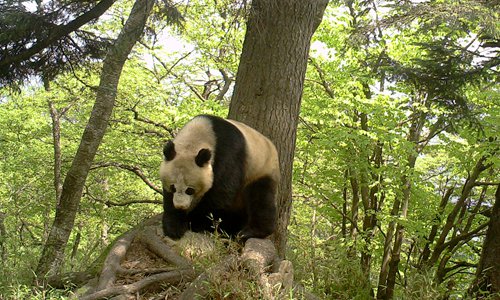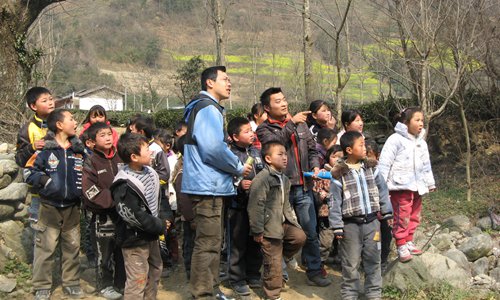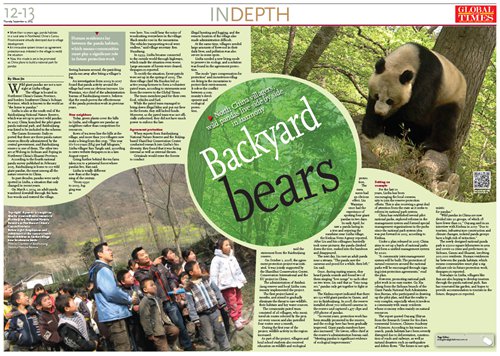HOME >> CHINA
North China villagers, wild pandas live side by side in harmony
By Shan Jie Source:Global Times Published: 2019/9/11 12:13:40

A panda is caught on film by a surveillance camera in Baishuijiang National Nature Reserve in Northwest China's Gansu Province. Photo: Courtesy of Baishuijiang National Nature Reserve
○ More than 10 years ago, panda habitats in a rural area in Northwest China's Gansu Province were virtually destroyed due to village development
○ An innovative system known as agreement protection was initiated in the village to rectify the situation
○ Now, this mode is set to be promoted as China plans to build a national park for pandas
Wild giant pandas are not a rare sight at Liziba village.
The village is located in Northwest China's Gansu Province, and borders Southwest China's Sichuan Province, which is known to the world as "the home to pandas."
Liziba is also at the south end of the Baishuijiang National Nature Reserve, which was set up to protect wild pandas. In 2017, China launched the pilot giant panda national park, and Baishuijiang was listed to be included in the scheme.
The Gansu Economic Daily reported that there are three panda nature reserves directly administered by the central government, and Baishuijiang reserve is one of them. The other two are at Wolong in Sichuan and Foping in Northwest China's Shaanxi Province.
According to the fourth national panda survey published in February 2015, Baishuijiang is home to 110 wild giant pandas, the most among all the nature reserves in China.
In past decades, pandas were rarely spotted in Liziba, a situation that only changed in recent years.
On March 1, 2014, an adult panda wandered downhill through the bamboo woods and entered the village. Seeing humans around, the panicking panda ran away after biting a villager's leg.
An investigation from 2009 to 2017 found that panda activity around the village had seen an obvious increase. Liu Wannian, vice chief of the administration bureau of Baishuijiang reserve, believes that the result proves the effectiveness of the panda protection work in previous years.
New neighbors
Today, green plants cover the hills in Liziba, and villagers see pandas as neighbors rather than competitors for resources.
Rows of tea trees line the hills at the village, and more than 700 villagers now make a living from this crop. "This year it's 600 yuan ($84) per half kilogram," Liziba villager Ran Tangfa said, according to news website thepaper.cn in a late-August report.
Going further behind the tea farm takes you to a primeval forest where pandas live, Ran said.
Liziba is totally different now than at the beginning of the century.
"From 1990 to 2003, logging was severe here. You could hear the noise of woodcutting everywhere in the village. Black smoke rose in the mountains. The vehicles transporting wood were endless," said village secretary Ren Huazhang.
In 1999, Liziba became connected to the outside world through highways, which made the situation even worse. Large amounts of forests were cleared, thepaper.cn reported.
To rectify the situation, forest patrols were set up in the spring of 2003. The then village chief Ma Xiaolun led 20 active young farmers to form a volunteer patrol team, according to statements sent from the reserve to the Global Times.
The team members paid for their own food, vehicles and fuel.
While the patrol team managed to bring down illegal kilns and put out fires in the forests, they still lacked funds. Moreover, as the patrol team was not officially authorized, they did not have much power to enforce the law.

Employees and volunteers at the reserve teach local children in Liziba village how to observe nature. Photo: Courtesy of Baishuijiang National Nature Reserve
Agreement protection
When experts from Baishuijiang National Nature Reserve and the Beijing-based ShanShui Conservation Center conducted research into Liziba's bio-diversity, they found that it was facing internal as well as external threats.
Criminals would enter the forests to conduct illegal hunting and logging, and the remote location of the village also made administration difficult.
At the same time, villagers needed large amounts of firewood in their daily lives, and pollution was also severe in some spots.
Liziba needed a new living mode to preserve its ecology, and a solution was found in the agreement protection.
The mode "pays compensation for protection" and incentivizes villagers living in the mountains to protect their environment. It solves the conflict between a community's development and ecological protection, said the statement from the Baishuijiang reserve.
On October 1, 2008, the agreement protection project was initiated. It was jointly supported by the ShanShui Conservation Center, Conservation International and the EU project in China.
The administration of Baishuijiang reserve and local Liziba community implemented the project.
The first project lasted 21 months, and aimed to gradually eliminate the threat to rare wildlife, their habitats and key water sources.
The community patrol team consisted of 26 villagers, who monitored six routes selected by the project every season and also patrolled four routes once a month.
During the first year of the project, wildlife activity in the region increased.
As part of the project, villagers and local school students also received education on wildlife and ecological protection.
The measures had an obvious effect. Liu Wannian once had the experience of spotting four giant pandas in two days.
In early April, he saw a panda lazing in a tree and enjoying the sunshine near Liziba village, the Xinhua News Agency reported. After Liu and his colleagues hurriedly took some pictures, the panda climbed down the tree, rushed into the bamboos and disappeared.
The next day, Liu met an adult panda near a stream. "The panda saw the cameras and posed for a while, then left," Liu said.
Once, during mating season, they heard panda sounds and found two of them singing "love songs" to each other on two trees. Liu said that as "lone rangers," pandas only get together to fight or mate.
The Xinhua report indicated that there are 132 wild giant pandas in Gansu, and 110 in Baishuijiang. In 2018, the reserve installed about 700 infrared cameras in the reserve and captured 1,477 clips and 788 photos of pandas.
"In recent years, protection work has been steadily promoted in the reserve, and the ecology here has been gradually improved. Giant panda numbers have also increased," He Liwen, office chief at the reserve's administration bureau said. "Meeting pandas is significant evidence of ecological improvement."
Setting an example
For the last 10 years, Liziba has been encouraging the local community to join the reserve protection efforts. This is also receiving a great deal of attention from the state as it seeks to reform its national park system.
China has established several pilot national parks, explored reforms in the management system and formed special management organizations in the parks since the national park system idea was put forward in 2013, according to Xinhua.
Under a plan released in 2017, China aims to set up a batch of national parks and form a unified management system by 2020.
"A community joint-management system will be built. The protection of natural resources around the national parks will be encouraged through signing joint-protection agreements," read the plan.
However, promoting national park pilot work is no easy matter. Gu Xiaodong from the Sichuan branch of the Giant Panda National Park Administration Bureau, who participated in drawing up the pilot plan, said that the reality is very complex, especially when it involves a community with many residents whose economy relies mainly on natural resources.
The report quoted Ouyang Zhiyun from the Research Center for Eco-Environmental Sciences, Chinese Academy of Sciences. According to his team's research, panda habitats have been severely disrupted due to deforestation, construction of roads and railways, as well as natural disasters such as earthquakes and debris flows. "The future is not optimistic for pandas."
"Wild pandas in China are now divided into 30 groups, of which 18 have fewer than 10," Ouyang said in an interview with Xinhua in 2017. "Due to tourism, infrastructure construction and climate changes, isolated panda groups have a high risk of extinction."
The newly designed national panda park is 27,100 square kilometers in area and covers 12 cities and prefectures in Sichuan, Gansu and Shaanxi, involving 200,000 residents. Human residences lay between the panda habitats, which means communities must play a significant role in future protection work, thepaper.cn reported.
Nowadays in Liziba, villagers like Ran are also hoping to develop tourism through the panda national park. Ran has renovated his garden, and hopes to provide accommodation to tourists in the future, thepaper.cn reported.

Newspaper headline: Backyard bears
Posted in: IN-DEPTH,ENVIRONMENT,CHINA FOCUS